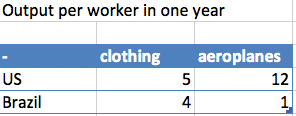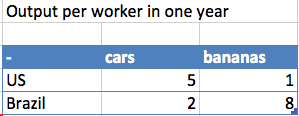- Absolute advantage means that an economy can produce a greater total of goods for the same quantity of inputs.
- Absolute advantage means that fewer resources are needed to produce the same amount of goods and there will be lower costs than other economies.
Simple example of absolute advantage
- In this example, Brazil has an absolute advantage in producing bananas (8 to 1).
- The US has an absolute advantage in producing cars (5 to 2)
Absolute advantage and labour costs
This is a different way of showing absolute advantage. Rather than show the output, we show the hours of labour required. This reflects the effective cost of production.
- In the above case, England has an absolute advantage in producing cloth (only requires 60 hours compared to Portugal’s 120).
- Portugal has an absolute advantage in producing wine (only requires 70 hours compared to 110 hours in England)
Absolute advantage in everything
It is possible for an economy to have an absolute advantage in everything. Whilst, some countries may have no absolute advantage in any goods or services.

In the above case, the US has an absolute advantage in producing clothing (5 to 4) and also has an absolute advantage in producing aeroplanes. (12 to 1)
Absolute vs Comparative advantage
Absolute advantage is concerned with producing at a lower cost. Comparative advantage is concerned with producing at a lower opportunity cost (ie. relatively better at producing)
Having absolute advantage doesn’t necessarily mean an economy should produce that good. It is not advisable to try and produce everything. It is more helpful to consider comparative advantage.
Comparative advantage measures the opportunity cost of producing a good.
- If the US produces clothing, the opportunity cost is 12/5 = 2.4 aeroplanes foregone.
- If Brazil produces clothing, the opportunity cost is 1/4 = 0.25 aeroplanes foregone.
- Therefore, the US should specialise in producing aeroplanes. Brazil should specialise in producing clothing (even though it doesn’t have an absolute advantage)
After specialisation
After specialisation, we assume countries are able to concentrate on doubling production because they produce only one good rather than two. Total output and economic welfare increases.
For example, one country may have an absolute advantage in many goods but it is better to focus on on goods where you have a relative advantage.
Absolute advantage in the workplace
Suppose:
- Susan can produce 11 cups of tea per hour and file 13 reports.
- Bob is a lazier worker and can only produce 10 cups of tea per hour and file 3 reports.
In this case, Susan has an absolute advantage in making cups of tea and filing reports.
- However, Susan should not try to do everything. She should specialise in compiling the reports, whilst Bob specialises in making cups of tea.
Notes about absolute advantage
- Absolute advantage can be hard to measure for many complicated goods because there are many different factor inputs.
Related
Published 12 November 2018, Tejvan Pettinger. www.economicshelp.org




Just a minor error, comparative advantage of aeroplanes in Brazil should be 1/4
Line – If Brazil produces clothing, the opportunity cost is 1/5 = 0.25 aeroplanes foregone.
yor comment is totaly wrong b/c comparative advantage is based on lower opportunity cost . countries with lower o.c is better off producing that good. i have degree in economics dear.
I have a degree* not I have degree. I don’t have a degree dear 😁
Sam, you are wrong please on the opportunity cost for Brazil it they decide to produce aeroplanes. The opportunity cost is not 1/4 but rather 4/1 = 4. This because they are forgoing producing 4 clothes only for one aeroplane. The O.C is therefore higher for them if they take this decision.
helpful but would like to know the defference btwn the comparative and absolute in detail
Thanks i got something new for ur presentation
LOL he’s is totally correct. Brazil has the comparative advantage is producing cloth,which the opprtunity cost of Cloth in brazil is lower than US
Thanks a lot… really helpful 🙏🙏🙏🙏🙏🙏
Tanks alot I’ve got everything for my presentation
Thanks a lot the document has really helped
I understood the lesson, I guess my students they are going to compliment me.
I very much enjoyed the notes, please keep publishing more for better clarification and details elaboration of the two subjects ( absolute and comparative advantage). I said this because on the context of relevance of absolute and comparative advantage is not detailed.
Wow I’m so thankful of you what a great lesson I learned from here I really appreciate you thanks for taking some absolutely advantage example.